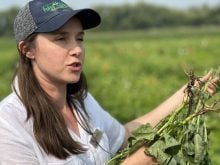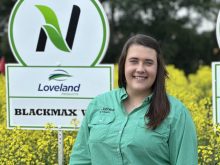Glacier FarmMedia — Dave Franzen is a straight shooter.
If he doesn’t know the answer, the North Dakota State University soil scientist will admit it; if he does, he’ll tell you.
As an example, in the summer of 2022 researchers from land grant universities across the north-central U.S. studied commercially available, biological nitrogen-fixing products to see if they increase crop yields.
Read Also

Cancer agency reclassifies another herbicide ‘probably carcinogenic’
The WHO’s cancer research agency has now put atrazine, a herbicide well known to corn growers, in the same potential-hazard category where the agency put glyphosate.
The results were collected, analyzed and the scientists published a paper in 2023.
Franzen, the lead author, said the products rarely worked.
“There was a very low frequency of what a farmer would call success,” he told growers, agronomists and industry reps in February at the CropConnect conference in Winnipeg.
The agricultural market for bacteria that can fix nitrogen and possibly deliver it to a plant is an emerging part of crop production.
Many companies, including global firms, are promoting their biologicals as products that can boost crop yield or allow a producer to cut fertilizer rates.
Many growers are curious about these products, especially in years when fertilizer prices are high.
Franzen’s paper reported only two cases where the biological products had an impact on yield.
“Sixty-one site years of N rate trials with and without the use of biological N fixing products were conducted in corn, spring wheat, sugar beet and canola in 10 states,” the report says. “(Only) two site-years in corn had yield increases due to product use over the N rates alone. Given the low rate of positive benefits … growers should be skeptical of products that claim to provide non-symbiotic N-fixation for the purpose of allowing a farmer to decrease fertilizer N rate.”
A success rate of two out of 61 is not great.
However, Franzen remains open to the idea that these products can work.
“It’s not zero anything in the jug. These things are natural.”
Following the publication of the NDSU report, six companies in the biological sector contacted Franzen to discuss his findings.
They acknowledged the challenges of getting biologicals to perform in real-world conditions.
One of the main issues is shipping.
It’s difficult to transport the products by plane, train or truck from a manufacturing plant to a farm because some bacteria can be highly sensitive to temperature. For instance, one product is supposed to be stored at 4 to 8 C, Franzen said.
“These things have to be alive to work. That’s the question: what does your supply chain look like? How are you going to keep them alive?”
Another challenge is that thousands or millions of microbes already exist in the soil.
A farmer could add a population of nitrogen-fixing bacteria, but there’s no guarantee of survival.
“If you try to put something in there that is foreign, (the other organisms) are going to try and kill it,” Franzen said. “If it’s not competitive, it will lose.”
Yet another obstacle is that these bacteria don’t live in synergy with the plant — they’re not symbiotic.
“Because they’re not attached to the plant, they’ll never supply all the nitrogen of the plant,” he said.
“They’re going to be limited by the limited supply of food outside of that root.”
Despite the limitations, growers may still be curious about these products and whether they can perform on their farm.
The only way to get that answer is replicated research on the farm, Franzen said.
He clarified that dividing a field in two and using a biological in one half of a field is not a replicated trial.
Farmers need to follow the proper protocols to get a useful result.
Manitoba Pulse and Soybean Growers operates an on-farm network that conducts trials across the province. It looked at a range of biological products from 2019-23.
“So far, we’ve tested 12 products over 28 trials in three different crops,” Laura Schmidt, a production specialist with MPSG, said at CropConnect.
Most of the trials were for soybeans, but they also tested the nitrogen-fixing biologicals on peas and dry beans. The results were extremely consistent.
“So far, we’ve not seen a yield increase with any of these products that we’ve tested,” Schmidt said, adding she’s 99 per cent confident in the results.
“I’m leaving that one per cent of the time where we might find this biological product that’s actually going to perform. That is something we would like to find.”
Franzen is also hopeful that the nitrogen-fixing, non-symbiotic products can work.
The evidence isn’t there, as of February 2024, but growers and the crop nutrition industry should be patient.
“We’re always short-sighted about this stuff. This is what we see, right now,” he said.
“But 10 years down the road, when all of this is worked out, if the investors are patient enough … to try and make sure it’s put out there in a manner that would be really beneficial and consistently beneficial to farmers, then you’ll see these kind of things (perform).”
ALSO: Biological certification program planned
Glacier FarmMedia — There are dozens of choices in the vitamin and supplement aisles at grocery and drug stores, to the point where consumers can be overwhelmed by the options.
What is ginkgo biloba and what does it do? Is it better than beta carotene?
The world of biological products in agriculture is similar. With hundreds on the market, growers may not understand how Product A is different from Product K.
The people who provide advice to growers may also struggle to know the difference, so Corteva AgriScience is stepping forward to fill the void.
“I can’t speak for everybody, but I can tell you that Corteva is launching a biological certification system for 2025 and beyond,” said Ryan Bonnett, Canadian commercial lead for biologicals at Corteva. “We want to bring people in and educate them on these products.”
The training will be directed at agronomists and retail representatives who are face to face with growers.
Most agronomists understand the details of fungicides, fertilizer and other cropping decisions, but for many, biologicals remain a black box.
“How do these things work the best? Where do I use them? What do they actually do? What’s the difference between this product and this product?” Bonnett said, listing some of the basic questions.
A certification program won’t answer every query, but more knowledge should shed some light.
















